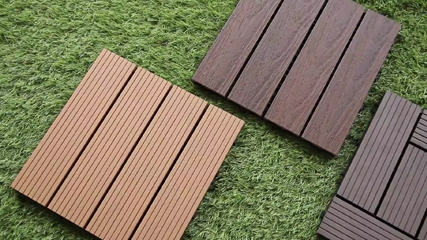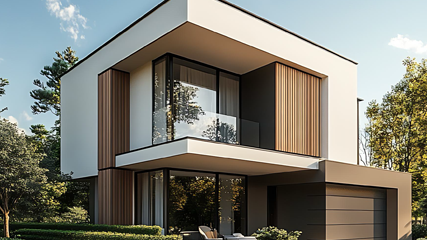1.Introduction to WPC Decking
In recent years, outdoor living spaces have become an extension of the home, with homeowners seeking stylish, durable, and low-maintenance solutions for patios, terraces, and gardens. One material that has gained widespread popularity in this context is WPC decking — a modern alternative to traditional wood that offers both aesthetic appeal and long-lasting performance.
What is WPC Decking?
WPC decking boards, or Wood Plastic Composite, decking is an innovative building material made from a blend of natural wood fibers and plastic polymers. The result is a composite board that mimics the look and feel of timber while offering enhanced durability and resistance to the elements. Unlike conventional wood, WPC decking does not splinter, rot, or warp, making it an ideal choice for outdoor use.
These composite boards are designed to provide the charm of real wood without the demanding upkeep. Whether used for a backyard deck, a poolside area, or a garden path, WPC decking delivers a clean, polished look that stands the test of time.
Benefits of Choosing WPC Decking
WPC decking comes with a host of benefits that make it a smart investment for homeowners and commercial projects alike:
Low Maintenance: Unlike natural wood, which requires regular sanding, staining, and sealing, WPC decking simply needs occasional cleaning to maintain its appearance.
Weather Resistant: WPC is highly resistant to moisture, UV rays, and temperature fluctuations, reducing the risk of warping, cracking, or fading.
Eco-Friendly: Made from recycled materials, WPC helps reduce waste and deforestation, making it an environmentally responsible choice.
Long-Lasting: With a lifespan that can exceed 20 years, WPC decking offers excellent value over time.
Safe and Comfortable: Many WPC boards feature anti-slip surfaces and stay cool underfoot, enhancing both safety and comfort in outdoor environments.
As outdoor living continues to grow in popularity, WPC decking stands out as a versatile, reliable, and attractive solution for modern landscaping and architectural needs.
2.Understanding Wood Plastic Composite (WPC)
To appreciate the advantages of WPC decking, it’s helpful to understand what Wood Plastic Composite actually is and how it’s made. WPC is not just a surface-level solution — it's a carefully engineered material that combines the best qualities of wood and plastic to create a high-performance, low-maintenance decking option.
Composition of WPC
WPC is composed primarily of two materials:
Wood Fibers or Flour: These are typically derived from recycled hardwood sawdust, wood chips, or other agricultural wood waste. The wood content gives WPC its natural appearance and structural strength.
Plastic Polymers: Commonly high-density polyethylene (HDPE), polypropylene (PP), or polyvinyl chloride (PVC), these plastics are often recycled and provide resistance to moisture and decay.
Additives: To improve performance, color, and durability, WPC also includes bonding agents, UV stabilizers, pigments, and anti-fungal compounds. These additives ensure long-term performance in a wide range of climates.
This blend results in a dense, durable material that is more stable than pure wood and more visually appealing than plain plastic.
Manufacturing Process
The production of WPC decking involves a few key stages, using a process called extrusion:
Material Mixing: The wood fibers, plastic, and additives are thoroughly mixed to ensure even distribution.
Extrusion: The mixture is heated and forced through a mold or die to create the shape of the decking board. This process allows for different profiles, including solid or hollow boards.
Cooling and Shaping: The hot composite is cooled rapidly to maintain its shape and is then cut to length.
Surface Finishing: Boards may be embossed with wood grain textures or brushed to achieve the desired look. Some are also capped with a protective outer layer to enhance stain and fade resistance.
3.Types of WPC Decking Boards
Choosing the right WPC decking board involves understanding the different types available, each offering unique benefits in terms of strength, aesthetics, and performance. Whether you’re planning a residential patio or a commercial terrace, selecting the right type ensures optimal results and long-term satisfaction.

Hollow vs. Solid WPC Decking
One of the most common distinctions in WPC decking board is between hollow and solid boards:
Hollow WPC Decking:Hollow boards are lighter in weight and often more budget-friendly. Their internal structure features a series of tubular channels, which reduce the amount of material used without significantly compromising strength. They are ideal for low-traffic areas or spaces where weight reduction is a priority, such as rooftop decks.
Solid WPC Decking:Solid boards are heavier and denser, offering superior strength and durability. They are better suited for high-traffic areas and environments that experience significant wear and tear. While they may be more expensive and slightly more challenging to install due to their weight, solid boards provide a more wood-like feel and greater longevity.
Capped vs. Uncapped WPC Decking
Another important consideration is whether the WPC decking is capped or uncapped:
Capped WPC Decking:These boards have a protective polymer shell or "cap" that encases the core material on one or more sides. The cap enhances resistance to moisture, stains, fading, and mildew, making the boards extremely low maintenance. Capped decking also often features more realistic wood grain patterns and color options.
Uncapped WPC Decking:Uncapped boards, sometimes referred to as first-generation WPC, do not have an outer protective layer. While still resistant to many environmental factors compared to wood, they are more susceptible to staining and color fading over time. However, they are generally more affordable and suitable for areas with limited exposure to harsh weather.
Different Textures and Colors
WPC decking is available in a broad range of textures, finishes, and colors to suit diverse design tastes and architectural styles. Some popular options include:
Woodgrain finishes for a traditional timber look.
Brushed or embossed surfaces for added grip and visual depth.
Contemporary shades like charcoal, silver grey, or coffee brown.
Natural hues that mimic cedar, oak, or mahogany.
4.Advantages of WPC Composite Decking
When choosing the right material for an outdoor deck, longevity, safety, and maintenance are crucial factors. WPC composite decking offers a modern alternative to traditional wood that outperforms in nearly every category. Here are the key advantages that make WPC composite decking a preferred choice among homeowners, architects, and builders.
Durability and Longevity
WPC decking is engineered to withstand harsh environmental conditions, from blazing sun to heavy rainfall. Unlike natural wood, it does not rot, crack, or splinter. The combination of wood fibers and plastic polymers creates a dense, stable material that resists structural damage over time. Most WPC decking boards come with warranties ranging from 10 to 25 years, reflecting their long-term performance and reliability.
Low Maintenance Requirements
One of the most attractive features of WPC decking is its minimal maintenance. Traditional wood decks often require regular sanding, painting, staining, and sealing to preserve their appearance. In contrast, WPC decking only needs occasional cleaning with soap and water to remove dirt and debris. This saves homeowners both time and money in upkeep.
Resistance to Weather and Pests
Thanks to its composite structure, WPC decking is highly resistant to moisture absorption, which means it won’t warp or swell due to humidity or rain. It also stands up well against UV exposure, reducing the risk of fading and surface damage. Additionally, WPC is impervious to termites, ants, and other wood-boring insects, making it a smart long-term investment in pest-prone areas.
Eco-Friendly Aspects
Environmental sustainability is another major advantage of WPC decking. Most products are made from recycled wood waste and plastic, helping to divert materials from landfills and reduce the need for virgin timber. By choosing WPC, consumers are not only getting a durable product but also contributing to responsible environmental practices.
5.Disadvantages of WPC Composite Decking
While WPC composite decking offers numerous benefits and has become a popular alternative to traditional wood, it’s important to consider its potential drawbacks. Like any material, WPC decking isn’t perfect and may not suit every budget or project. Understanding the limitations can help homeowners and contractors make well-informed decisions.
Initial Cost Considerations
One of the most significant disadvantages of WPC decking is its higher initial cost. Compared to pressure-treated wood or softwood options, composite decking materials can be noticeably more expensive. The cost stems from the complex manufacturing process and the use of advanced materials, including recycled plastics and wood fibers.
However, it's worth noting that this upfront expense is often balanced out over time due to lower maintenance costs and longer lifespan. Still, for those on a tight budget or undertaking large-scale projects, the initial price tag can be a barrier.
Potential for Fading
Although many WPC decking boards are treated with UV inhibitors or protective caps, fading over time—especially with uncapped or lower-quality products—is still possible. Prolonged exposure to sunlight can cause slight discoloration or a dulled appearance, particularly in darker shades or in climates with intense UV radiation.
To minimize this issue, consumers should consider:
Choosing capped WPC boards, which have a protective layer to guard against UV rays.
Installing decking in partially shaded areas, if possible.
Opting for lighter colors, which tend to show less noticeable fading.
6.Installation Guide for WPC Decking Boards
Installing WPC decking is a relatively straightforward process, especially when compared to traditional timber. However, following best practices is crucial to ensure a durable, safe, and visually appealing result. This section outlines the tools you'll need, the step-by-step installation process, and common mistakes to avoid.
Tools and Materials Needed
Before beginning your WPC decking installation, gather the following tools and materials:
WPC decking boards
Subframe materials (aluminum, plastic, or treated wood joists)
Hidden fasteners or stainless-steel screws
Electric drill or screwdriver
Measuring tape
Spirit level
Circular saw or miter saw
Spacers or clips
Protective gear (gloves, goggles)
Having the right tools on hand will help streamline the process and reduce the risk of installation errors.
Step-by-Step Installation Process
1. Prepare the Ground and Substructure
Start by clearing and leveling the installation area. Ensure proper drainage by slightly sloping the base away from structures. Lay a weed barrier if needed.
2. Install the Joists
Place your joists on the prepared ground, spaced approximately 30–40 cm apart (check manufacturer guidelines). Secure them in place using appropriate ground fixings. Joists must be level and stable to support the decking properly.
3. Lay the First Board
Position the first WPC composite decking at the edge of the deck. Use starter clips to secure it to the joist. Make sure it’s straight and properly aligned.
4. Continue Laying Boards
Attach the next board using hidden fasteners or clips, which fit into the grooves on the side of the boards. These clips ensure even spacing and a clean, screw-free surface. Continue this process until all boards are in place.
5. Trim and Finish Edges
Once all boards are secured, trim any overhanging ends using a circular saw. Install edge trims or fascia boards for a neat, professional finish.
6. Final Inspection
Check that all boards are secure, evenly spaced, and level. Make any necessary adjustments before enjoying your new decking area.
Common Mistakes to Avoid
Avoid these frequent errors to ensure your WPC decking performs well over time:
Insufficient spacing: WPC decking expands and contracts with temperature changes. Always leave expansion gaps between boards and at the ends.
Incorrect substructure: Using an unstable or uneven subframe can lead to poor board alignment and structural issues.
Skipping drainage planning: Water pooling beneath the decking can lead to moisture-related problems. Ensure proper water runoff.
Using wrong fasteners: Always use the recommended clips or stainless-steel screws. Incompatible fasteners can damage the boards or reduce longevity.
7.Maintenance and Care for WPC Decking
One of the standout advantages of WPC (Wood Plastic Composite) decking is its low-maintenance nature. Unlike traditional wood decks that require frequent staining, sealing, and repairing, WPC decking only needs basic care to retain its appearance and performance over time. However, routine attention and preventative practices can extend its life even further and keep it looking like new.
Regular Cleaning Tips
While WPC composite decking is highly resistant to stains, mold, and mildew, occasional cleaning is still recommended to keep it looking its best.
Routine Sweeping: Use a broom or leaf blower to regularly remove dirt, leaves, and debris that can accumulate between the boards or cause staining over time.
Washing: Clean the deck surface with warm soapy water and a soft-bristle brush or mop. For deeper cleaning, a mild household detergent can be used.
Pressure Washing: If necessary, a pressure washer can be used on a low setting (no more than 1500 psi) and with a wide-angle nozzle. Always keep the spray moving and avoid getting too close to prevent surface damage.
Mold and Mildew: Though uncommon, mold can grow on dirt or pollen sitting on the deck. Clean affected areas using a solution of vinegar and water or a composite decking cleaner designed for mold.
Preventative Measures
Preventative care is key to avoiding long-term issues and maintaining the deck’s visual appeal.
Avoid Standing Water: Ensure proper drainage by keeping gaps between boards clear and avoiding blocked edges or drains.
Furniture Pads: Use rubber or plastic furniture pads under heavy items to prevent scratches and dents.
Protect from Stains: Place mats or trays under grills, planters, and outdoor furniture that may leak grease, rust, or other staining substances.
Snow and Ice: Use a plastic shovel (never metal) to clear snow, and opt for calcium chloride-based de-icers instead of rock salt, which can damage the surface.
Avoid Harsh Chemicals: Never use bleach, acetone, or abrasive cleaners, as they may discolor or erode the surface.
8.WPC Decking vs. Traditional Wood Decking
When choosing materials for outdoor decking, one of the most common decisions homeowners face is whether to go with Wood Plastic Composite (WPC) or traditional timber decking. While both options have their merits, they differ significantly in terms of cost, performance, maintenance, and environmental impact. Here’s a detailed comparison to help you make an informed choice.
Comparison of Cost
At first glance, traditional wood decking—especially softwoods like pine—often appears to be the more affordable option. The initial purchase price of wood boards is generally lower than that of WPC. However, this can be misleading when considering long-term expenses.
WPC decking may come with a higher upfront cost, but it typically requires less maintenance and fewer repairs, which significantly reduces expenses over time. With wood, regular treatments such as sanding, staining, sealing, and even replacing damaged boards add to the total cost of ownership.
In summary:
Wood Decking: Lower initial cost, higher ongoing maintenance.
WPC Decking: Higher initial investment, lower long-term costs.
Comparison of Lifespan
When properly maintained, high-quality hardwood decking can last 15–20 years. However, in climates with high humidity or intense sun exposure, wood can deteriorate faster if not treated regularly.
WPC decking, on the other hand, offers a lifespan of 20–30 years with minimal upkeep. It is highly resistant to rot, mold, termites, and warping, giving it a considerable edge in durability and reliability over time.
In summary:
Wood Decking: Susceptible to weathering, pests, and decay; shorter lifespan without frequent maintenance.
WPC Decking: Long-lasting, low-maintenance, and resistant to most environmental stressors.
Environmental Impact
Sustainability is a growing concern for many consumers, and both decking types have environmental pros and cons.
Traditional wood decking uses natural lumber, which—when sourced responsibly—can be a renewable resource. However, overharvesting and the need for chemical treatments (to resist insects and decay) can reduce its eco-friendliness.
WPC composite decking is typically made from a combination of recycled plastics and reclaimed wood fibers, helping to divert waste from landfills and reduce demand for virgin timber. Some manufacturers also employ eco-friendly production practices, further lowering the carbon footprint.
In summary:
Wood Decking: Renewable but may involve deforestation and chemical treatments.
WPC Decking: Often made from recycled materials and designed for sustainability.
Conclusion of the Comparison
Choosing between WPC and traditional wood decking ultimately comes down to your priorities. If you value natural aesthetics and lower upfront costs, wood may be suitable. But if you prefer durability, low maintenance, and long-term savings, WPC decking is the superior choice. It's especially well-suited for homeowners who want a beautiful, reliable outdoor space without the constant upkeep.
9.Design Ideas with WPC Decking
One of the standout features of WPC decking is its versatility in design. Whether you're working with a small balcony or a sprawling backyard, WPC decking can be adapted to suit a wide range of outdoor layouts and aesthetics. With a variety of colors, finishes, and board types available, you can create personalized spaces that are both functional and visually striking.
Creating Outdoor Living Spaces
WPC decking is perfect for transforming outdoor areas into cozy, usable living spaces. Here are a few popular ideas:
Patios and Entertainment Areas: Create a seamless extension of your home by designing an outdoor lounge with WPC decking. Add furniture, ambient lighting, and a pergola or shade sail for a comfortable entertainment zone.
Rooftop Terraces: Lightweight and low-maintenance, WPC boards are ideal for rooftop installations. Combine with potted plants and modular seating to make the most of urban outdoor space.
Balconies: WPC decking adds warmth and elegance to balconies, offering a wood-like finish without the upkeep. Opt for narrow-profile boards to make compact areas appear more spacious.
Integrating with Landscaping
WPC decking doesn’t just stop at flat surfaces—it can be creatively integrated into the surrounding landscape:
Decking Pathways: Use WPC boards to create winding garden paths or bridges over water features. Their non-slip properties make them a safe choice even in damp environments.
Multi-Level Decking: Introduce levels and steps to define different zones—such as dining, lounging, or grilling areas—adding depth and dimension to your outdoor layout.
Built-In Planters and Benches: For a cohesive look, construct planter boxes, seating, or raised beds using the same WPC material. This approach maintains visual consistency and durability.
10.Cost Analysis of WPC Decking
When considering new decking material, cost is one of the most important factors for homeowners and developers alike. While Wood Plastic Composite (WPC) decking may have a higher upfront cost compared to traditional wood, a deeper look into the long-term financial implications reveals a different story. WPC decking often proves to be a more cost-effective investment over time.
Initial Investment
WPC decking boards generally cost more per square meter than untreated softwood or even pressure-treated lumber. The price reflects the material’s enhanced durability, advanced manufacturing process, and built-in resistance to environmental wear. Additionally, installation costs may vary slightly due to the use of specialized clips or hidden fastener systems, but these often lead to cleaner aesthetics and quicker installation over time.
Despite the higher initial price tag, choosing WPC decking means you are investing in a product that requires far fewer resources for upkeep, repair, or replacement.
Long-Term Savings
What sets WPC apart in terms of cost is its minimal maintenance requirements. Unlike timber, which demands regular sanding, staining, sealing, or even plank replacement due to rot or insect damage, WPC decking retains its appearance and structural integrity with just basic cleaning.
Some of the key long-term financial benefits include:
No need for annual treatments such as sealants or paints
Fewer repairs due to its resistance to cracking, warping, and decay
Extended lifespan, which reduces the need for early replacement
Reduced labor and maintenance costs over the years
Over a 10–20 year span, the money saved on maintenance, materials, and labor often offsets the initial price difference — and in many cases, leads to overall cost savings.
11.Common Problems and Solutions for WPC Decking
| Problem | Description | Recommended Solution |
|---|---|---|
| Fading | Color fading due to prolonged UV exposure, especially on uncapped boards and darker colors. | - Choose capped WPC decking with UV-resistant coating. - Use shade structures or outdoor rugs to reduce sun exposure. - Accept slight natural fading that stabilizes over time. |
| Staining | Potential stains from grease, food, plant debris if spills are left untreated. | - Clean spills promptly with warm soapy water and a soft brush. - Use mild household or composite deck cleaners for stubborn stains. - Prefer capped decking for high-risk areas. |
| Expansion and Contraction | Boards expand and contract with temperature changes, causing possible buckling or gaps if not installed correctly. | - Follow manufacturer guidelines for spacing during installation. - Use appropriate clips/fasteners allowing thermal movement. - Avoid installation in extreme temperatures. |
While WPC decking is known for its durability and low maintenance, like any material, it may occasionally present some challenges. Understanding the most common issues — and how to address them — can help homeowners extend the life and beauty of their WPC decks.
Fading
Problem: Over time, exposure to direct sunlight can cause some fading in the color of uncapped WPC decking. This is more noticeable in boards with darker pigments or when only part of the deck is exposed to UV rays.
Solution:To prevent or minimize fading:
Choose capped WPC decking, which includes a protective layer that resists UV damage.
Use outdoor rugs, umbrellas, or pergolas to provide shade and reduce direct sunlight.
Understand that minor fading may occur in the first few months and then stabilize, creating a more natural weathered look.
Staining
Problem: Spills from food, beverages, oil, or grease can stain the surface, especially on uncapped boards or if left uncleaned for too long.
Solution:
Clean spills promptly using warm soapy water and a soft-bristle brush.
For tougher stains, use a composite decking cleaner recommended by the manufacturer.
Avoid placing grills or planters directly on the deck without mats to catch drips or runoff.
Expansion and Contraction
Problem: Like most materials, WPC composite decking expands and contracts with temperature changes. Poor installation without proper spacing can lead to buckling or gaps between boards.
Solution:
Ensure correct installation practices, particularly regarding expansion gaps and joist spacing.
Follow the manufacturer’s guidelines on fastening systems and layout direction.
If installing in regions with significant seasonal temperature changes, use hidden fastener systems that allow for natural board movement.


























